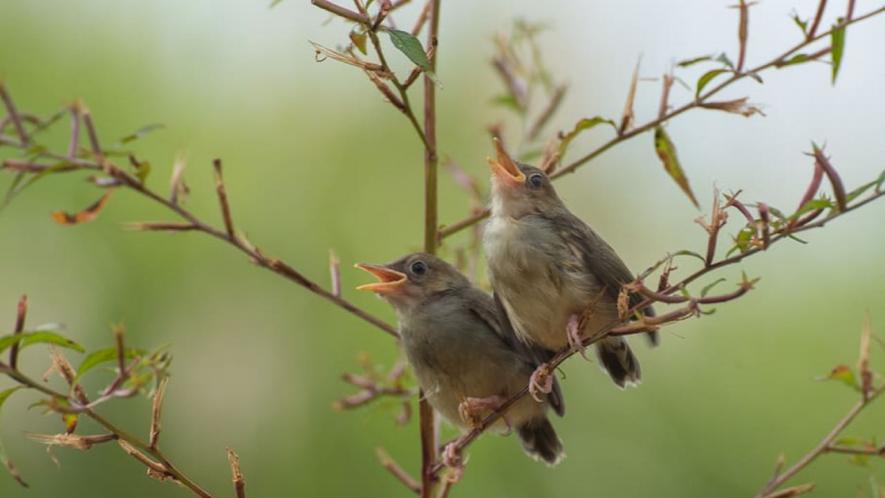Where do Living Creatures get Their Sense of Rhythm?

Representational image
The science of rhythm across species is a new and growing research field, as yet without agreement on the question of whether the phenomenon of rhythm exists for every species. There is, however, fascinating and suggestive experimental and observational evidence: Parrots can bob their heads to a beat; rats can synchronise head movement to music; the cockatoo Snowball is famous for dancing; the California sea lion Ronan can move to music but does not vocalise; and chimpanzees can beat rhythmically on hollow tree trunks.
Research on human musicality is also advancing; one study found that foetuses were attuned to the rise and fall in the sound of music and speech (cadence) by the last three months in the womb. Further, their baby cries mimicked the cadence of the mother’s native tongue, lilting upward in French and descending in German.
Animals singing and dancing in time to music may seem perfectly natural to human audiences familiar with Disney and other cartoon characters. In reality, each species varies in its capacity to perceive a beat and coordinate movement with it, a synchronised process called entrainment. The research on entrainment in non-human species in the past decade alone has changed the way scientists think about rhythm across species and how it works.
Yet, a consensus on entrainment is still lacking. Although studies have found that dolphins, bats, and songbirds can learn vocal patterns, some researchers have determined that these species have “no evidence of rhythmic entrainment.” An opposing view holds that there is, “in fact, no convincing case” against beat-matching in animals, and that it could be widespread.
As a non-specialist looking at the emerging evidence, the second view seems more likely.
How Rhythm Works
One of the basic questions in the science of rhythm is whether the brain mechanisms enabling rhythm and entrainment are similar in humans and nonhumans.
The physical mechanism of rhythm and synchrony—matching motion, like tapping a foot or bobbing a head—in non-human species is an open research question. The perception of simple rhythms, patterns, periodicities, and the pattern of beats in a musical piece should all be investigated, a 2021 review of the field recommends.
There are two major competing hypotheses of the brain architecture involved in rhythm: gradual audiomotor evolution and vocal learning, each with experimental data to back it up. Gradual audiomotor evolution focuses on the brain’s neural circuit interaction of hearing and movement and does not link with vocal perception. The vocal learning hypothesis centres on the idea that the brain has a preadaptation for vocal cues that evolves genetically and culturally.
The gradual audiomotor evolution hypothesis holds that rhythmic entrainment, the ability to perceive a beat and coordinate movement with it rhythmically, is a complex phenomenon in the human brain involving hearing and the motor system (movement) in a two-way interaction. Until recently, scientists thought that this is a specifically human ability, but newer research indicates that some non-human primates and other animals have the ability to perceive a beat and match it to movements.
Among animals found to have rhythmic entrainment, there are wide variations in aptitude. Some experimental studies found that Rhesus monkeys, when trained, could tap to match a tempo, but macaques could not.
The empirical data from many different experiments suggest that chimpanzees and humans have similar neural circuits involved in perceiving rhythm patterns and that the neural circuits of macaques are less evolutionarily developed in this ability. Doubters of this conclusion suggest that there is so little data that more research might find that macaques are also musically trainable.
Interestingly, the same study found that macaques could synchronise their arm movements with visual cues, but not with vocal cues. (Picture pairs of macaques facing each other, moving their arms in synchronous rhythm.)
An Alternative Hypothesis: Vocal Learning
Vocal learning is an alternative hypothesis, first proposed in 2006, which instead looks at vocal perception and the neural circuit–how sound is perceived and what it is connected to in the brain. When the original vocal learning hypothesis was proposed, there was as yet no research showing beat perception and synchronisation in non-human animals, either in the field or in the laboratory.
Based on more recent experimental data, a 2021 study has updated the vocal learning hypothesis. The revised view holds that vocal learning is a “preadaptation for sporadic beat perception and synchronization” that emerges from the coevolution of genes and culture. In other words, a preexisting neural structure develops the ability of a species to take on a new function, in this case, entrainment.
Humans have a specialised sound and motion (auditory-motor) circuitry in their brains which enables more complex vocal learning, this theory proposes. The human brain has existing neural oscillations—electrical activity or brain waves—and these get stimulated by sounds outside the body and add new oscillations—waves of regular movement back and forth—to the existing ones.
The vocal learning proponents suggest that vocal learning capacities exist in a continuum across species, providing many areas for further research in beat perception, synchronisation, and cognitive gene and culture coevolution.
So far, there is a lack of research into the coevolution of genes and culture, the 2021 study notes, so vocal learning research into the neural specialisations that develop could help move general knowledge of coevolution forward. The study points to one coevolution area as an example, the anatomical changes accompanying lactose tolerance that developed 10,000 years ago in dairying cultures.
What About Human Rhythm?
The importance of music in all human cultures is well documented, but how and why it developed evolutionarily is still being investigated as part of the broader question of rhythm. To take one example, recent research indicates that beat perception is probably not the result of the heartbeat, as initially thought, but requires “specific neural networks.”
Another approach is to look at music culturally, as does a 2023 anthropological study supported by the Leakey Foundation, asking why music is ubiquitous across cultures.
An international team of researchers tested hypotheses of the function of music and singing by studying the hunter-gatherer Mbendjele BaYaka people in the Republic of Congo. For two years, the researchers observed a group of BaYakan women who spontaneously sang as they foraged in the rainforest for tubers and other food, concluding that singing produced community spirit, averted potential conflict, and in the words of the BaYakas, made the forest “happy.”
The team was investigating two hypotheses for the evolution of music: first, that singing developed as a tool to signal solidarity in the group and affirm a “willingness” to work together, and second, that it warned against possible dangers. Additionally, the researchers explored the function of mothers singing to their infants.
The researchers observed 1,704 separate foraging trips, 19% of which involved singing. The evidence clearly supported the first hypothesis, that the women sang to affirm cooperation and avoid conflict, especially in groups of less familiar women. There was no indication that the purpose of singing was to deter predatory animals. In fact, the researchers found that the BaYaka sing to “please the forest” so that the forest would provide more food.
Another tantalising possibility is that “touch triggers singing”; the women were more likely to sing when they were holding an infant. They yodelled loudly or patted the infant’s back rhythmically when the child cried.
The study concludes that “music could have originated to signal coalition, particularly cooperative intent or intention to form coalitions within and between groups,” and it suggests future research on coalition signalling in other societies.
A Work in Progress
Based on this brief look at current research among humans and non-humans, the answer to the question of whether all species have rhythm is “yes.” How exactly this works, how it evolved, and rhythm’s present role in animal and human communication are research topics in progress. Stay tuned!
Marjorie Hecht is a longtime magazine editor and writer with a specialty in science topics. She is a freelance writer and community activist living on Cape Cod.
This article was produced by Human Bridges, a project of the Independent Media Institute.
Get the latest reports & analysis with people's perspective on Protests, movements & deep analytical videos, discussions of the current affairs in your Telegram app. Subscribe to NewsClick's Telegram channel & get Real-Time updates on stories, as they get published on our website.
























